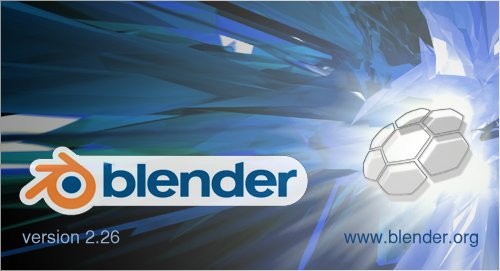 Blender was originally developed as an in-house tool for a commercial animation company in 1995. In 1998, it distributed as a shareware program and it became open source since 2002.
Blender was originally developed as an in-house tool for a commercial animation company in 1995. In 1998, it distributed as a shareware program and it became open source since 2002.
Interested to know more about the history of Blender’s development? Here is a gallery of Blender splash screens from version 2.04 to 2.49 captured by running the programs downloaded from Blender official directory. If you are looking for splash screens of Blender newer versions, you can find it on Blender Splash Screens 2.5 – 2.6.
Blender 2.04 (October 2000)
This was the earliest release that has a splash screen I can find on the web.
Blender 2.25 (October 2002, aka Blender Publisher 2.25)
This version was a NaN (Not a Number) commercial release, available as a freeware download.
Blender 2.26 (February 2003)
This was the first open source release.
Blender 2.27 (May 2003)
International Language support for Blender interface was added to this release.
Blender 2.28 (July 2003)
Notable feature in this release was playback of audio can be synced in 3D window and Sequence editor.
Blender 2.28c (September 2003)
Metaball editing and environment maps have been improved in this release.
Blender 2.30 (October 2003)
Blender’s interface has been greatly improved in this release to make navigating and learning Blender easier.
Blender 2.31 (November 2003)
This was a bugfix release, no notable features were added.
Blender 2.31a (December 2003)
This was a bugfix release, no notable features were added.
Blender 2.32 (February 2004)
Ray tracing rendering and displacement mapping were added to this release.
Blender 2.33 (April 2014)
Highlights of this release were resurrection of the Game Engine and inclusion of Ambient Occlusion rendering.
Blender 2.33a (May 2004)
This was a bugfix release, no notable features were added.
Blender 2.34 (August 2004)
In this release, Yafray can be integrated with Blender as a plug-in.
Blender 2.35 (November 2004)
A new global undo system has been added to this release.
Blender 2.36 (December 2004)
Support for normal maps has been added to this release.
Blender 2.37 (May 2005)
Soft Body system and Catmull-Clark subdivision surfaces were added to this release.
Blender 2.37a (June 2005)
This was a bugfix release, no notable features were added.
Blender 2.40 Alpha 1 (October 2005, aka 2.39)
This was an official testing build, no notable new features were added.
Blender 2.40 Alpha 2 (November 2005 aka 2.39)
This was an official testing build, no notable new features were added.
Blender 2.40 (December 2005)
Fluid Dynamics system was added to this release.
Blender 2.41 (January 2006)
GLSL Pixel and Vertex shaders for Game Engine were added to this release.
Blender 2.42 (July 2006)
Material (Shading) Nodes were added to this release.
Blender 2.42a (July 2006)
This was a bugfix release, no notable features were added.
Blender 2.43 (February 2007)
The highlights were multi-resolution meshes, muli-level UV, multi-layer images, multi-pass rendering.
Blender 2.44 (May 2007)
Subsurface scattering (SSS) support was added.
Blender 2.45 (September 2007)
This was a bugfix release, no notable features were added.
Blender 2.46 (May 2008)
New particle system with hair and fur combing tools was supported in this release.
Blender 2.47 (August 2008)
This was a bugfix release, no notable features were added.
Blender 2.48 (October 2008)
Game logic editing and character animation were improved in this release.
Blender 2.48a (October 2008)
This was a bugfix release, no notable features were added.
Blender 2.49 (May 2009)
Significant work has been done on the game engine in this release.
Blender 2.49a (June 2009)
This was a bugfix release, no notable features were added.
Blender 2.49b (August 2009)
This was a bugfix release, no notable features were added.
































